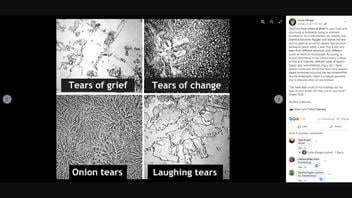
Do tears from different emotions look different under a microscope due to the specific emotion? Not exactly: The appearance of all tears vary under a microscope for reasons that include the tears' biological make-up and how the tears dry.
The claim appeared in a Facebook post (archived here) on January 21, 2022. The post supposedly featured four microscopic images of tears produced from different circumstances: grief, change, interaction with an onion and laughing. The caption of the post reads in part:
Emotions have chemical levels in your brain and your body is constantly trying to maintain equilibrium. So if one emotion sky rockets, that chemical becomes flagged and signals the tear duct to open as an exit to release that emotion packaged neatly within a tear. This is also why tears from different emotions look different under an electron microscope. According to Joseph Stromberg of the Smithsonian's College of Arts and Sciences, different types of tears--happy, sad, overwhelmed, angry, etc.--have distinct molecules. Emotional tears have protein-based hormones including the neurotransmitter leucine enkephalin, which is a natural painkiller that is released when we are stressed.
This is what the post looked like on Facebook on January 27, 2022:
(Source: Facebook screenshot taken on Thu Jan 27 21:14:58 2022 UTC)
The microscopic images shown in the post are from a project titled "The Topography of Tears" by photographer Rose-Lynn Fisher. During a period of grief, Fisher conceived of her project and decided to capture the appearance of tears under a microscope. The tears were produced in a variety of situations from both herself and volunteers.
According to the American Academy of Ophthalmology, there are three different classifications of tears. Emotional tears are generated from emotion, basal tears are used to protect and lubricate various areas of the eye and reflex tears are a response to outside stimuli such as onion fumes or dust.
However, tears' appearances vary in far more ways than the way they are produced. The information from Joseph Stromberg cited in the post's caption is from an article titled "The Microscopic Structures of Dried Human Tears" that highlights Fisher's project. The "distinct molecules" discussed in the article are in reference to findings that suggest that emotional tears contain protein-based hormones, some of which are released when the body is under stress. But Stromberg's article also points to several other factors that determine tears' appearances under a microscope regardless of their type, including the presence of biological substances and how the tears dry. Thus, the appearances of all tears are different no matter the circumstance.
In an email to Lead Stories on January 27, 2022, Fisher told us that every tear she observed had its own qualities or "'signature' whether it was from the same emotion or different emotions." She clarified that her project is "a contemplative study and a reflection on what connects humanity at the most basic levels." As for the claim in the Facebook post, she said:
Misinformation abounds on social media, even when it's being shared with the best of intentions, but not fact-checked with the source -- and unfortunately here, my work on the tears has gotten distorted over the years as it's been reposted. The labeling of emotions on the graphic, along with some of the text with this meme, imply that my images are depicting the different chemical and biological makeup of tears as if this was an established, conclusive fact represented by the graphic. This can make my work sound like faux science. It's important to emphasize that there are no 'claims' to refute, for I made no claims nor conclusions about the tears I looked at.
Fisher also said that she does not authorize her work to be included in any kind of graphic that is posted without her permission.

















